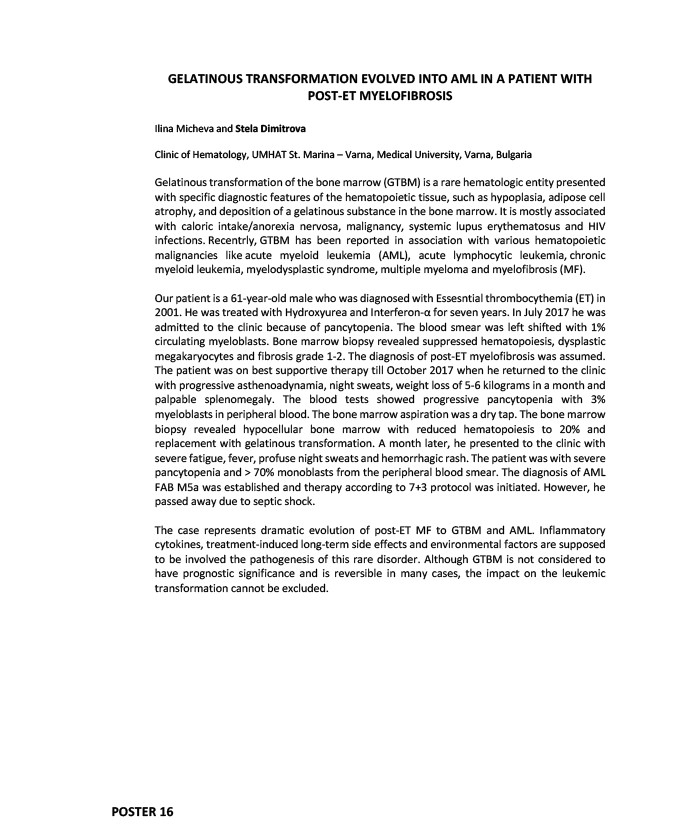
GELATINOUS TRANSFORMATION EVOLVED INTO AML IN A PATIENT WITH
POSTER 16
POST-ET MYELOFIBROSIS
Ilina Micheva and Stela Dimitrova
Clinic of Hematology, UMHAT St. Marina – Varna, Medical University, Varna, Bulgaria
Gelatinous transformation of the bone marrow (GTBM) is a rare hematologic entity presented
with specific diagnostic features of the hematopoietic tissue, such as hypoplasia, adipose cell
atrophy, and deposition of a gelatinous substance in the bone marrow. It is mostly associated
with caloric intake/anorexia nervosa, malignancy, systemic lupus erythematosus and HIV
infections. Recentrly, GTBM has been reported in association with various hematopoietic
malignancies like acute myeloid leukemia (AML), acute lymphocytic leukemia, chronic
myeloid leukemia, myelodysplastic syndrome, multiple myeloma and myelofibrosis (MF).
Our patient is a 61-year-old male who was diagnosed with Essesntial thrombocythemia (ET) in
2001. He was treated with Hydroxyurea and Interferon-α for seven years. In July 2017 he was
admitted to the clinic because of pancytopenia. The blood smear was left shifted with 1%
circulating myeloblasts. Bone marrow biopsy revealed suppressed hematopoiesis, dysplastic
megakaryocytes and fibrosis grade 1-2. The diagnosis of post-ET myelofibrosis was assumed.
The patient was on best supportive therapy till October 2017 when he returned to the clinic
with progressive asthenoadynamia, night sweats, weight loss of 5-6 kilograms in a month and
palpable splenomegaly. The blood tests showed progressive pancytopenia with 3%
myeloblasts in peripheral blood. The bone marrow aspiration was a dry tap. The bone marrow
biopsy revealed hypocellular bone marrow with reduced hematopoiesis to 20% and
replacement with gelatinous transformation. A month later, he presented to the clinic with
severe fatigue, fever, profuse night sweats and hemorrhagic rash. The patient was with severe
pancytopenia and > 70% monoblasts from the peripheral blood smear. The diagnosis of AML
FAB M5a was established and therapy according to 7+3 protocol was initiated. However, he
passed away due to septic shock.
The case represents dramatic evolution of post-ET MF to GTBM and AML. Inflammatory
cytokines, treatment-induced long-term side effects and environmental factors are supposed
to be involved the pathogenesis of this rare disorder. Although GTBM is not considered to
have prognostic significance and is reversible in many cases, the impact on the leukemic
transformation cannot be excluded.